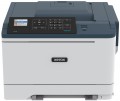Monthly resource
The maximum number of pages the printer can print in a month while still operating at full capacity.
Mono cartridge resource
The maximum number of pages that the printer's ink (toner) can print. The value is rather conditional, in reality the deviations from the norm are very large (up or down). In inkjet printers, the cartridge life is relatively small and amounts to several hundred prints. In laser and LED devices, the bill is already in the thousands.
Colour cartridge resource
The maximum number of pages that the printer's ink (toner) can print. The value is rather conditional, in reality the deviations from the norm are very large (up or down). In inkjet printers, the cartridge life is relatively small and amounts to several hundred prints. In laser and LED devices, the bill is already in the thousands.
Cartridge model
The types of cartridges (both black and white and colour) used in the printer. Some printer models are able to work with "non-native" cartridges, but this feature usually refers to undocumented features, and the manufacturer's warranty covers only specific types of cartridges. So use "non-native" models with caution.
Cloud print
Cloud print service supported by the printer. Specified only if the device is capable of working with cloud services directly without connecting to a PC.
The general principle of such printing is that documents sent for printing are stored on a server on the Internet. Thus, the availability of the printer is not limited to the local network — you can send documents for printing from anywhere in the world where there is access to the World Wide Web. In addition,
cloud-based printers make it easy to share with others.
Screen
The type of screen provided in the design of the printer. This parameter is indicated by two points — colour (monochrome or
colour display), as well as the absence or
presence of a touch screen(if only colour is indicated, then the screen is not touch).
Chroma determines the features of the image on the display. Monochrome (black and white) screens allow you to display a lot of different information, and are inexpensive. On the other hand, such a display is poorly suited for viewing drawings and photographs sent for printing — for such purposes it is better to use more expensive, but more functional colour screens.
As for touch displays, they provide additional convenience in management and expand its capabilities. Various controls can be displayed on such a screen — sliders, lists, text menus, etc.; operating them with touches on the display is easier than using traditional control panels with hardware buttons. On the other hand, the presence of a sensor affects the cost of the display, and it makes sense to use this feature mainly in advanced printers with an abundance of additional functions.
Screen size
The diagonal of the display installed in the printer.
The larger the display, the more convenient it is to use, the better you can see the image on it. Large-screen printers are especially useful when you need to view a variety of graphics on the screen. In addition, a large diagonal is highly desirable for touch screens (see "Display"). On the other hand, the larger the display, the more expensive it is and the more space it takes up, despite the fact that a small diagonal is enough for basic tasks and settings.
Clock Speed
The clock speed of the processor installed in the printer. Theoretically, a higher clock speed improves performance and, accordingly, the actual speed of operation. However, in fact, these indicators depend on so many additional factors that the processor frequency is a purely reference parameter, and when choosing, it is worth focus on more “close to life” characteristics — print speed, first sheet output time, etc.
Feed tray
The number of sheets of paper that the input tray can hold—that is, the tray from which blank paper is taken for printing. Note that this amount is usually specified based on standard office paper with a density of about 80 g/m²; if thicker paper is used for printing, fewer sheets will fit in the feed tray.

